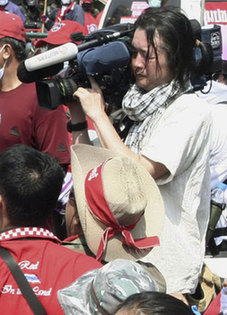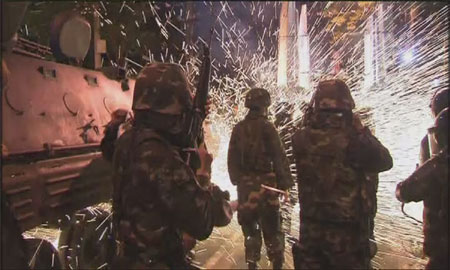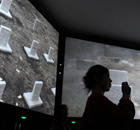Newsmaker
Reuters cameraman's chilling last picture show
(Agencies)
Updated: 2010-04-12 19:49
 |
Large Medium Small |
BANGKOK - Seven minutes of film taken by Reuters cameraman Hiro Muramoto illustrate how a scrappy street protest turned deadly on a balmy Bangkok night.
|
 Reuters television cameraman Hiro Muramoto films anti-government protesters facing Thai security force during clashes in central Bangkok in this April 10, 2010 file photo. [Photo/Agencies] |
It is some of the last video Muramoto, 43, a father or two young children, ever took. He died on Saturday from a gunshot wound to the chest, his killer unknown.
The film encapsulates the fear, the tension and the sudden, chilling bloodshed after a month of protests by Thailand's "red shirts" whose anti-government protests had largely been festive and peaceful until then.
Muramoto, a Japanese national who had worked for Reuters in Tokyo for more than 15 years, arrived in Thailand on Thursday. He was taken to hospital two days later without a pulse. The bullet had entered his chest and exited the body through the back.
His camera was returned to Reuters by the protesters. It is not known if the footage was his very last.
The red shirts are demanding the immediate downfall of Prime Minister Abhisit Vejjajiva and fresh elections. Troops fired rubber bullets and tear gas at the demonstrators who retaliated with petrol bombs and other weapons.
EXPLOSION NEAR CAMERAMAN
Muramoto's footage starts behind army lines, with soldiers framed by the Democracy Monument, the scene of the city's worst street violence in 1992 near the Phan Fah Bridge in Bangkok's old quarter.
Soldiers in full riot gear are standing with their rifles pointing in the air. There is the continuous sound of gunfire. One soldier glances at Muramoto twice in a nervous but unthreatening way.
Then an explosion just yards in front of where Muramoto is standing sends at least four soldiers to the ground in a spray of sparks and smoke. Two get up and limp away.
Another television cameraman runs frantically into Muramoto and past him. Soldiers carrying riot shields jostle into him as they, too, get away. Muramoto somehow keeps filming, retreating by walking slowly backwards.
|
 Image shows part of the April 10, 2010 video footage taken by Reuters cameraman Hiro Muramoto before he was shot in the chest. [Photo/Agencies] |
The camera focuses on a soldier lying on the ground, starry eyed but alive with a bloody wound to the neck. Colleagues undo a flak jacket from around his neck.
In the next frame, troops drag a soldier, obviously in pain, by the arms, his rifle scuffling along the road surface alongside him. Another motionless body is dragged away.
The camera focuses on a trail of blood on the tarmac that shines in the street lights under the banners celebrating this week's Songkran festival, one of the happiest holidays in the Thai calendar.
The soldiers retreat and suddenly the camera angle changes to show the red shirt ranks. Most are carrying sticks and some are wielding shields apparently taken from the soldiers. Many are waving, beckoning someone from behind the camera.
Some are frantically talking to soldiers, others are throwing objects in the air, one of which feebly catches the bunting overhead and falls harmlessly to the ground.
No one in sight is paying any attention to the camera, which keeps rolling.
But it is around this point, at an intersection, that TV footage from other sources show gunmen on the run, dressed not in red shirts or green army fatigues, but in black and dark, civilian clothes.
The government has talked of a "third force" involved in the protests and has promised to investigate the circumstances surrounding Muramoto's death.






